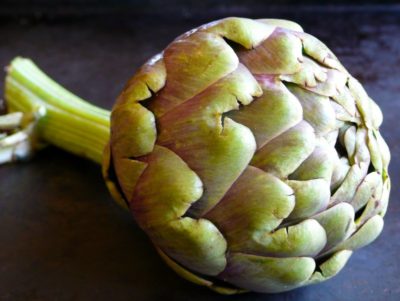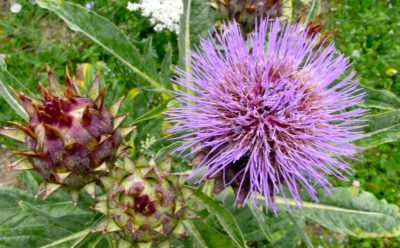
Artichoke
Artichoke is a thistle which is grown for the edible parts of the immature flowers.
Cardoon (Cynara cardunculus) is the same species as artichoke, but it is a wild variety. The stems are eaten as a vegetable.
The cultivated form (globe artichoke) is called Cynara cardunculus var. scolymus.
Names
Scientific
Cynara cardunculus
Synonym
Cynara cardunculus var. scolymus
Cynara scolymus
English
Artichoke
Artichoke thistle
Cardoon
Globe artichoke
Wild artichoke
Dutch
Artisjok
Kardoen
Spanish
Alcachofa
Alcaucil
French
Artichaut
German
Artischocke
Italian
Carciofo
Taxonomy
Order
Asterales
Family
Asteraceae
Genus
Cynara
Species
Cynara cardunculus (Artichoke)
Basic information and facts
Origin:
Southern Europe.
Distribution:
Highest production of artichokes is in the mediterranean region: Italy, Spain, Egypt, France, Morocco. Other important producers include Peru, Argentina, Chile, China, Morocco, USA and South Africa.
Annual, biennial, or perennial:
Artichoke is a perennial plant.
Flowers:
The flowers are purple and develop in a large head from an edible bud with a diameter of 8 to 15 cm surrounded by hard triangular scales. These “scales” are bracts, which are modified leaves. The fleshy lower portions of these bracts and the base (heart) are the edible parts of the flower head.
Leaves:
The arching leaves are deeply lobed and have a silvery grayish-green color.
Plant:
Individual plants can grow indefinitely. Every year the plant is sprouting new shoots near the surface of the ground. At the place where the new shoot lands, it forms a rosette and then a new stalk will grow up.
Climate and weather:
Prefers a Mediterranean climate or areas that get no frost in winter and have cool and foggy summer weather.
Pollination:
By insects.
Height:
The plants can be 1 to 2 meters tall.
Type of soil:
Prefers deep, fertile, well-drained soil, but can grow on different types of soil as well.
Spacing (close range)
1 meter between plants
Spacing (wide range)
2 meters between plants
Propagation:
Artichoke is usually propagated using crown divisions or shoots as this gives a good quality plant. Plants grown from seed show a lot of variation and not all of them may be useful.
Insect pests and Diseases:
Artichokes have few insect pests and few diseases.
Harvesting:
Immature flowers are harvested by cutting the stem 3 to 5 centimeters below the base of the bud. The old stems are then also removed to get new stems growing.
Uses:
The edible parts of the flower are used as a vegetable.
Proverbs and Quotes
- His memoir is a splendid artichoke of anecdotes, in which not merely the heart and leaves but the thistles as well are edible. (John Leonard)
- Life is like eating artichokes, you have got to go through so much to get so little. (Thomas Aloysius Dorgan)
- These things are just plain annoying. After all the trouble you go to, you get about as much actual “food” out of eating an artichoke as you would from licking 30 or 40 postage stamps. (Miss Piggie)
- A woman is like an artichoke, you must work hard to get to her heart. (Inspector Jacques Clouseau in The Pink Panther, 2006)
Recipes
No recipe yet
Crop categories
Arid crops
Cool temperate crops
Flower vegetables
Medicinal plants
Mediterranean crops
Minor crops
Subtropical crops
Temperate crops
Vegetables
Pictures

Artichoke

Artichoke

Artichoke flower

Artichokes for sale in a market

Artichokes

Cardoon

Cardoon
